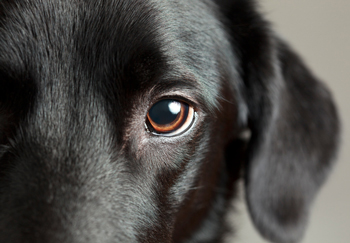Common Eye Conditions in Dogs

Dogs suffer from many of the same eye conditions that humans do, and some of them can cause pain or blindness. This is an overview of some of the most common eye problems that are diagnosed in dogs, with links to more in-depth articles on each condition.
Conjunctivitis
Conjunctivitis is inflammation of the tissues in the eyes.
Conjunctivitis can be caused by a variety of agents, including bacteria, viruses, and irritants, and it can also occur secondarily to other conditions such as eye injuries.
Dogs with conjunctivitis have redness in the tissues under their eyelids. They may be squinting or pawing at their eyes, and they usually have excessive ocular discharge.
You can learn more in our article: "Conjunctivitis in Dogs."
Glaucoma
Glaucoma is increased pressure in the eye. It is a painful condition that causes the eye to become enlarged and eventually leads to blindness. Glaucoma can occur in dogs as a primary or secondary condition.
Primary glaucoma means that the high pressure in the eye is its own condition, not caused by another disease process. It is more common in certain dog breeds, such as chows, Shi tzus, and Siberian huskies.
Secondary glaucoma occurs when another disease process, such as cataracts or an ocular tumor, causes the increased eye pressure.
Dogs with glaucoma may squint, paw at their eyes, have redness in the whites of their eyes, and even appear to have a bulging eye.
You can visit the article, "Glaucoma in Dogs," to learn more.
Cataract
A cataract is a clouding of the lens of the eye. The lens is used for focusing, and a cataract can interfere with sight. Cataracts may occur in any age dog, and they can form because of genetics, certain infections, trauma to the eye, deficiency of particular nutrients, or other factors.
You can learn more in our article, "Cataracts in Dogs."
Corneal Ulcer
A corneal ulcer is a sore or wound that affects the outermost covering of your dog's eye, the cornea. These usually occur because of some type of trauma, such as a scratch. They may also form because of another disease process in the eye that causes corneal irritation, like entropion or KCS (see below).
An ulcer on the cornea usually causes a dog to squint the affected eye, and there is often drainage from the eye, as well. The condition is painful, so your dog may rub at her eye with a paw or try to rub it on surfaces such as furniture or carpet. This can further damage the eye and should be discouraged.
You can learn more details about this condition here: "Corneal Ulcers in Dogs."
Entropion
Entropion occurs when a dog's eyelid turns inward abnormally, causing the eyelashes to rub on the cornea of the eye. This may result in one or more corneal ulcers (see above) over time.
Entropion is a genetic condition in some breeds, including boxers, chows, and bulldogs. Surgery is usually required to correct a dog's eyelid conformation and eliminate the rubbing of the eyelashes on the cornea.
More information can be found here: "Entropion in Dogs."
Horner's Syndrome
Horner's Syndrome is a neurological condition that affects the nerve that controls the eye. It generally occurs on one side, and it results in a cluster of signs that include:
- A droopy upper eyelid.
- A constricted pupil in the affected eye.
- A sunken appearance to the affected eyeball.
- Prolapse of the nictitans membrane (third eyelid), which spreads out from the inner corner of the eyeball and covers a portion of the eye.
- A sagging appearance of the muscles on the affected side of the face.
Horner's Syndrome indicates an interruption of the nerve on that side of the face, and the cause could be anything from trauma to a bad ear infection to a tumor along the nerve's path.
You can find out more about this condition in our article, "Horner's Syndrome in Dogs."
Progressive Retinal Atrophy
PRA, or progressive retinal atrophy, is a slow degeneration of the retinal tissue at the back of the eye that is critical for sight. It is an inherited condition which is common in several dog breeds including collies, schnauzers, and golden retrievers.
Due to its progressive nature, there may be few or no signs of this condition until the dog is completely blind. However, you may notice your dog having more trouble seeing at night first, then progressively more trouble during the day.
There is no treatment for PRA, but it is not painful to the dog. You can learn more here: "Progressive Retinal Atrophy: PRA in Dogs."
Anterior Uveitis
The uvea of the eye is between the cornea and the retina. It contains the ciliary body, the iris, and the choroid. Anterior uveitis is an inflammation of the uvea, and it can be caused by a wide variety of conditions including trauma, cancer, and bacterial or viral infection.
Anterior uveitis is painful to the dog, can lead to other eye problems, and may eventually result in loss of sight.
You can learn more about the causes, diagnosis, and treatment of this condition here: "Anterior Uveitis in Dogs."
Keratoconjunctivitis Sicca (KCS)
A dog's cornea, or outermost layer, normally contains three different tear layers. In KCS, there is an interruption of the center layer, which results in a drying out of the cornea. The eye then becomes inflamed, irritated, and sore.
The most common cause of KCS in dogs is an auto-immune problem that causes the body to attack its own lacrimal tear glands. Breeds that are most commonly affected by KCS include American cocker spaniels and pugs.
Other conditions that may cause KCS include some canine viruses and certain medications.
Dogs with KCS usually have irritated corneas, redness in the whites of their eyes, and copious amounts of thick ocular discharge.
More information on this condition is available here: "KCS: Keratoconjunctivitis Sicca in Dogs."
You May Also Like These Articles:
Gazing into Your Dog's Eyes Releases Love Hormone
A General Guide to Puppy Safety
Cognitive Dysfunction Syndrome: Senility in Dogs
How to Get Dog Urine out of Carpet
Disclaimer: This website is not intended to replace professional consultation, diagnosis, or treatment by a licensed veterinarian. If you require any veterinary related advice, contact your veterinarian promptly. Information at DogHealth.com is exclusively of a general reference nature. Do not disregard veterinary advice or delay treatment as a result of accessing information at this site. Just Answer is an external service not affiliated with DogHealth.com.
Notice: Ask-a-Vet is an affiliated service for those who wish to speak with a veterinary professional about their pet's specific condition. Initially, a bot will ask questions to determine the general nature of your concern. Then, you will be transferred to a human. There is a charge for the service if you choose to connect to a veterinarian. Ask-a-Vet is not manned by the staff or owners of DogHealth.com, and the advice given should not delay or replace a visit to your veterinarian.



